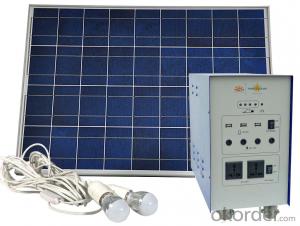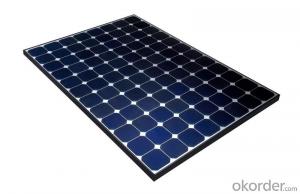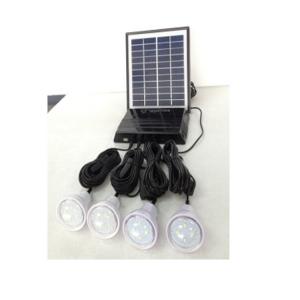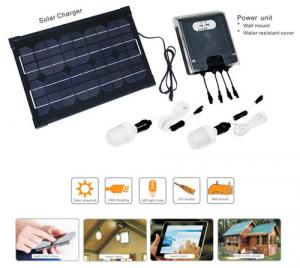Solar Energy Systems for Homes - CNBM On Grid System 60000W with Certificate UL TUV CE
- Loading Port:
- Shanghai
- Payment Terms:
- TT OR LC
- Min Order Qty:
- 10 watt
- Supply Capability:
- 1000 watt/month
OKorder Service Pledge
OKorder Financial Service
You Might Also Like
Specification
CNBM On Grid System 60000W with Certificate UL TUV CE
Product description
They range from small residential and commercial rooftop systems to large utility-scale solar power stations. Unlike stand-alone power systems, a grid-connected system rarely includes an integrated battery solution, as they are still very expensive. When conditions are right, the grid-connected PV system supplies the excess power, beyond consumption by the connected load, to the utility grid.
Connection of the photovoltaic power system can be done only through an interconnection agreement between the consumer and the utility company. The agreement details the various safety standards to be followed during the connection.[4]
The price of solar power, together with batteries for storage, has continued to fall so that in many countries it is cheaper than ordinary fossil fuel electricity from the grid (there is "grid parity").[4]
Off-the-grid is a system and lifestyle[1] designed to help people function without the support of remote infrastructure, such as an electrical grid. In electricity, off-grid can be stand-alone power system or mini-grids typically to provide a smaller community with electricity. Off-grid electrification is an approach to access electricity used in countries and areas with little access to electricity, due to scattered or distant population. The term off-the-grid (OTG) can refer to living in a self-sufficient manner without reliance on one or more public utilities. People who adopt this lifestyle are called off-gridders.[2]

Application
Industrial
Commercial
Residential
Feature
Residential, grid-connected rooftop systems which have a capacity more than 10 kilowatts can meet the load of most consumers.[2] They can feed excess power to the grid where it is consumed by other users. The feedback is done through a meter to monitor power transferred. Photovoltaic wattage may be less than average consumption, in which case the consumer will continue to purchase grid energy, but a lesser amount than previously. If photovoltaic wattage substantially exceeds average consumption, the energy produced by the panels will be much in excess of the demand. In this case, the excess power can yield revenue by selling it to the grid. Depending on their agreement with their local grid energy company, the consumer only needs to pay the cost of electricity consumed less the value of electricity generated. This will be a negative number if more electricity is generated than consumed.[3] Additionally, in some cases, cash incentives are paid from the grid operator to the consumer.
Packaging
With carton and box
- Q: Can solar energy systems be used for powering research laboratories or scientific facilities?
- Yes, solar energy systems can definitely be used for powering research laboratories or scientific facilities. Solar power can provide a reliable and sustainable source of electricity to meet the energy needs of these facilities. It can help reduce their carbon footprint, lower energy costs, and provide a more secure and independent energy source. Additionally, advancements in solar technology and energy storage systems have made it possible to generate and store enough power to meet the high energy demands of research laboratories and scientific facilities.
- Q: What is the cost of installing a solar energy system?
- The cost of installing a solar energy system can vary depending on various factors such as the size of the system, the type and quality of solar panels used, the complexity of the installation, and any additional equipment required. On average, the cost of installing a solar energy system can range from $10,000 to $30,000 or more. However, it is important to note that there are various incentives and tax credits available that can significantly reduce the upfront cost of installation. Additionally, over the long term, installing a solar energy system can result in significant savings on electricity bills, as the system generates clean and renewable energy, reducing reliance on traditional energy sources. It is advisable to consult with a professional solar installer to get an accurate estimate based on your specific requirements and location.
- Q: How do solar energy systems impact the electrical grid?
- Solar energy systems can have a positive impact on the electrical grid by reducing the overall demand for electricity and decreasing the reliance on fossil fuel-based power generation. When connected to the grid, solar systems can feed excess electricity back into the grid, helping to stabilize and balance the supply-demand dynamics. However, the intermittent nature of solar power may pose challenges for grid operators in managing fluctuations in generation, necessitating grid upgrades and energy storage solutions to ensure grid stability and reliability.
- Q: Can solar panels be installed on different types of roofs?
- Yes, solar panels can be installed on different types of roofs including flat, sloped, shingled, metal, and tile roofs. The installation process may vary depending on the roof type, but with proper mounting systems and professional installation, solar panels can be successfully installed on various roof types.
- Q: Can solar energy systems be used in powering hotels or resorts?
- Certainly, hotels and resorts can make use of solar energy systems to power their facilities. Solar power is a renewable and clean energy source that can effectively meet the energy requirements of these establishments. Hotels and resorts typically consume a substantial amount of energy for various purposes, such as lighting, heating, cooling, and running electrical appliances and equipment. To harness the abundant sunlight, hotels and resorts can opt to install solar panels on their rooftops or in open areas. This allows them to convert sunlight into electricity, which can then be used to power the entire facility. By doing so, these establishments reduce their dependence on traditional energy sources, resulting in a decreased carbon footprint. In addition to its environmental advantages, solar energy systems can offer financial benefits to hotels and resorts. By generating their own electricity, these establishments can significantly lower or eliminate their utility bills, leading to substantial cost savings in the long run. Furthermore, some countries provide incentives, grants, or tax credits for the implementation of solar power systems, making such installations economically viable. Moreover, the availability of solar energy is not limited to sunny days. With advancements in technology, solar panels can still generate electricity even during cloudy or overcast conditions. Furthermore, any excess energy produced during peak sunlight hours can be stored in batteries for later use, ensuring a steady power supply throughout the day and night. By adopting solar energy systems, hotels and resorts can demonstrate their commitment to sustainability and environmental responsibility. This can serve as a valuable marketing tool, attracting environmentally conscious guests who prefer eco-friendly accommodations. It also aligns with the growing trend of sustainable tourism, enhancing the reputation and competitiveness of these establishments in the industry. Overall, solar energy systems are a practical and efficient solution for powering hotels and resorts. They offer a multitude of benefits, including reduced utility costs, environmental sustainability, and increased market appeal. As technology continues to advance and become more affordable, more hotels and resorts are embracing solar power as a reliable and clean energy source.
- Q: Can a solar energy system be integrated with other renewable energy sources?
- Indeed, it is possible to integrate a solar energy system with various other renewable energy sources. In reality, the combination of multiple renewable energy sources can yield numerous advantages. By integrating solar energy with wind, hydro, or geothermal power, for example, we can establish a more dependable and environmentally friendly energy system. One advantage of integrating solar energy with other renewables is the consistent generation of electricity. Since solar energy production relies on sunlight, it can vary throughout the day and across seasons. However, by combining solar power with other renewable energy sources that have different production patterns, we can ensure a more steady and reliable energy supply. Furthermore, the integration of multiple renewable energy sources can enhance the overall efficiency of the system. Different renewable sources possess varying strengths and weaknesses. For instance, wind energy production is highest at night when solar energy is not available. By merging these two sources, we can optimize resource utilization and reduce waste. Moreover, the integration of solar energy with other renewables can help overcome geographical limitations. Certain regions may have excellent solar resources but limited wind or hydro potential. By combining different renewable energy sources, we can capitalize on the strengths of each source and establish a more balanced and diverse energy portfolio. Lastly, the integration of multiple renewables can contribute to a more sustainable and resilient energy system. As renewable energy technologies continue to advance, we can harness the benefits of each source while minimizing environmental impact. By diversifying our energy sources, we can reduce our reliance on fossil fuels and mitigate the risks associated with climate change. In conclusion, integrating a solar energy system with other renewable energy sources allows for the creation of a more reliable, efficient, and sustainable energy system. By combining different renewables, we can overcome the limitations of individual sources and maximize the benefits of each. This integration plays a crucial role in transitioning towards a greener and more resilient future.
- Q: Can solar energy systems be used for powering recycling or waste management facilities?
- Yes, solar energy systems can certainly be used for powering recycling or waste management facilities. Solar panels can be installed on the rooftops or open spaces of these facilities to harness sunlight and convert it into electricity. This renewable energy can then be used to power various operations within the facility, such as conveyor belts, sorting machines, compactors, shredders, and other equipment used in the recycling or waste management processes. Using solar energy for powering recycling or waste management facilities has several advantages. Firstly, it helps to reduce the dependence on traditional energy sources, such as fossil fuels, which are not only expensive but also contribute to environmental pollution and climate change. Solar energy is abundant and free, making it a sustainable and cost-effective option in the long run. Furthermore, solar energy systems have a low maintenance requirement, as solar panels have no moving parts and are designed to withstand harsh weather conditions. This makes them highly reliable and suitable for continuous operations in recycling or waste management facilities. Another benefit of using solar energy in these facilities is that it can offset the electricity costs associated with operating heavy machinery. Recycling and waste management facilities often have high energy demands due to the nature of their operations. By harnessing solar power, these facilities can significantly reduce their electricity bills, resulting in cost savings over time. Moreover, solar energy is clean and does not produce any greenhouse gas emissions or air pollutants during operation. This aligns with the goals of recycling and waste management facilities, which aim to minimize environmental impact and promote sustainable practices. By using solar energy, these facilities can further reduce their carbon footprint and contribute to a greener and more sustainable future. In conclusion, solar energy systems can be effectively used for powering recycling or waste management facilities. They offer numerous advantages, including reduced dependence on traditional energy sources, cost savings, low maintenance requirements, and environmental sustainability. As the technology continues to advance and become more affordable, it is expected that solar energy will play an even larger role in powering these facilities in the future.
- Q: What is the lifespan of a solar battery?
- The lifespan of a solar battery can vary depending on several factors. Generally, a well-maintained solar battery can last anywhere from 5 to 15 years. However, some high-quality batteries have been known to last up to 20 years or more. The lifespan of a solar battery is influenced by factors such as the quality of the battery, the depth of discharge, the number of charge cycles, and the environmental conditions it is exposed to. The quality of the battery is crucial as it determines its overall durability and performance. Investing in a high-quality battery can significantly extend its lifespan. Additionally, the depth of discharge, which refers to how much capacity is used from the battery before recharging, can affect its lifespan. Shallower discharges can help prolong the battery's life. The number of charge cycles also affects a solar battery's lifespan. A charge cycle refers to the process of discharging the battery and then recharging it. The more charge cycles a battery undergoes, the shorter its lifespan will be. Therefore, minimizing the number of deep discharge cycles can help extend its life. Lastly, the environmental conditions play a role in a solar battery's lifespan. Extreme temperatures, both hot and cold, can negatively impact battery performance and reduce its overall lifespan. Adequate temperature control and protection from harsh weather conditions can help preserve the battery's longevity. Regular maintenance and proper care, such as cleaning the solar panels and ensuring the battery is not exposed to extreme temperatures, can help maximize the lifespan of a solar battery.
- Q: How does a solar energy system convert sunlight into electricity?
- A solar energy system converts sunlight into electricity through a process called the photovoltaic effect. This effect occurs in solar panels, which are made up of multiple silicon cells. When sunlight hits the solar panels, it is absorbed by the silicon cells, which are semiconductors. The energy from the sunlight excites the electrons in the silicon atoms, causing them to break free from their atomic bonds and create an electric current. This current is in the form of direct current (DC), which is not suitable for most household appliances. Therefore, an inverter is used to convert the DC electricity into alternating current (AC), which is the standard type of electricity used in homes and businesses. The AC electricity produced by the solar energy system can then be used to power various appliances and devices in a building. If the system produces more electricity than is being used, the excess can be stored in batteries for later use or fed back into the grid through a process called net metering. In summary, solar energy systems convert sunlight into electricity by using solar panels to absorb the sunlight and generate an electric current through the photovoltaic effect. This current is then converted from DC to AC and can be used to power buildings or stored for later use.
- Q: Can solar energy systems be used in areas with low sunlight?
- Yes, solar energy systems can still be used in areas with low sunlight. While solar panels are most effective in areas with abundant sunlight, advancements in solar technology have made it possible to generate electricity even in areas with lower sunlight levels. Additionally, solar energy systems can still provide a reliable source of energy in such areas by utilizing battery storage to store excess energy generated during periods of higher sunlight and using it during times of lower sunlight.
Send your message to us
Solar Energy Systems for Homes - CNBM On Grid System 60000W with Certificate UL TUV CE
- Loading Port:
- Shanghai
- Payment Terms:
- TT OR LC
- Min Order Qty:
- 10 watt
- Supply Capability:
- 1000 watt/month
OKorder Service Pledge
OKorder Financial Service
Similar products
Hot products
Hot Searches
Related keywords

























